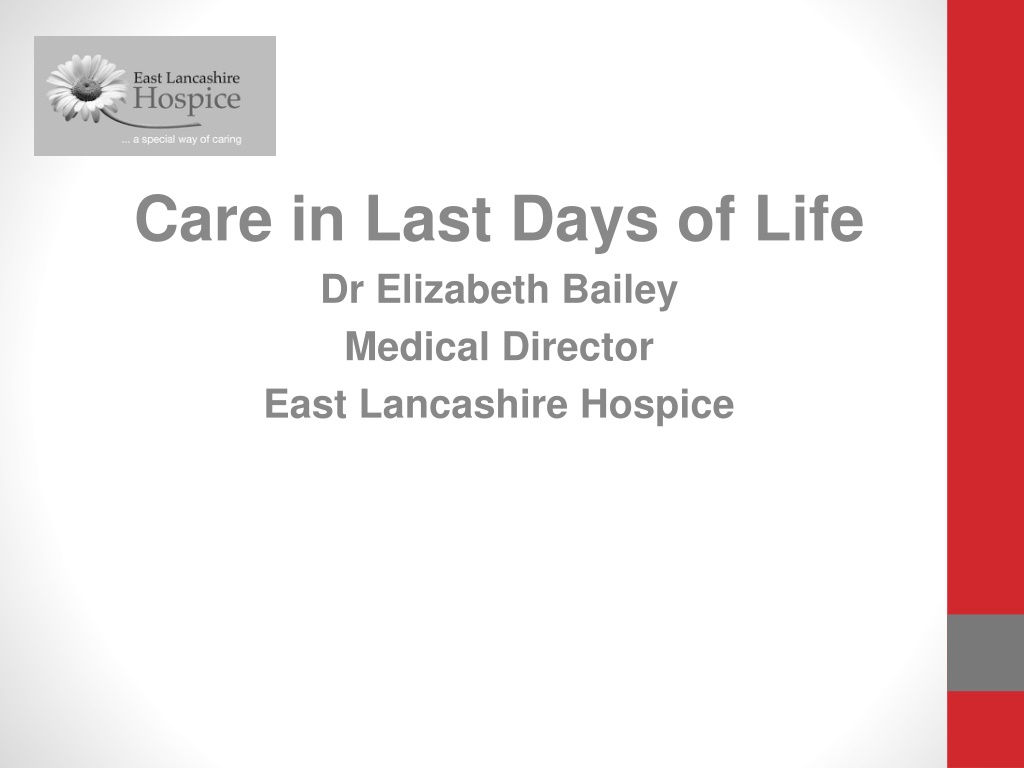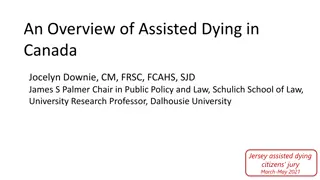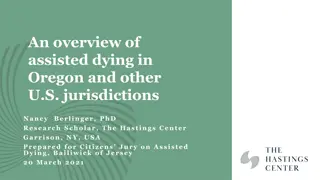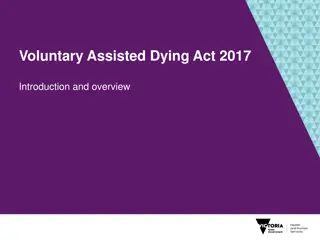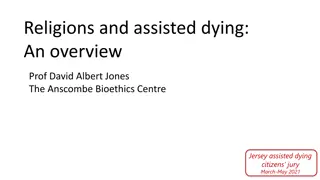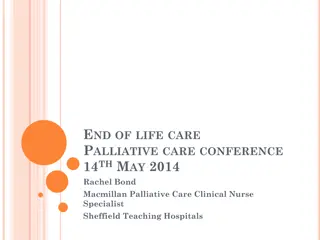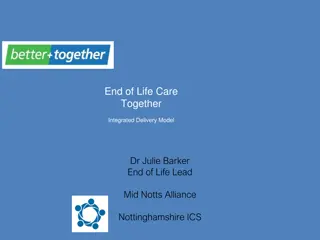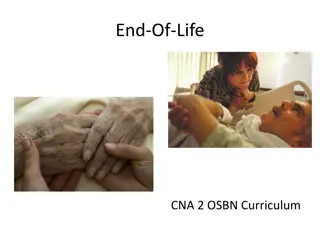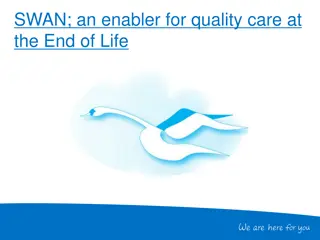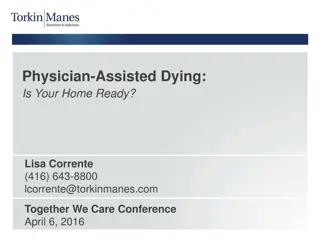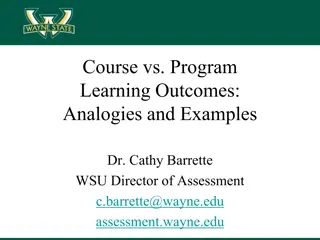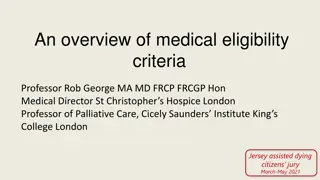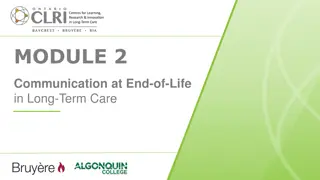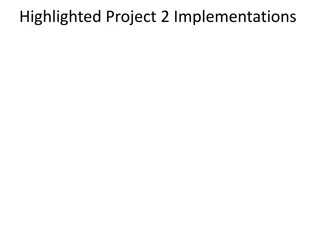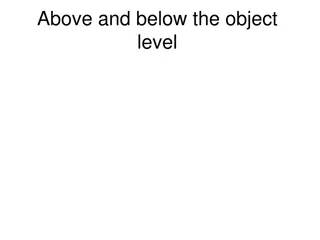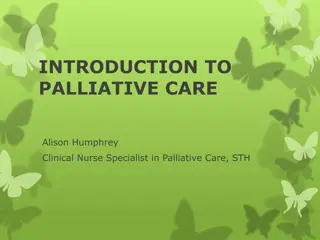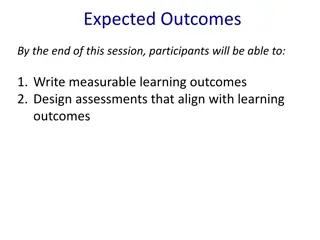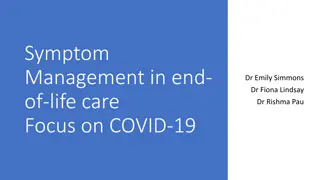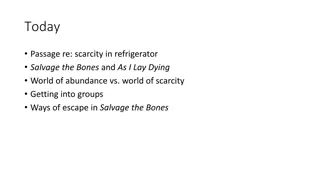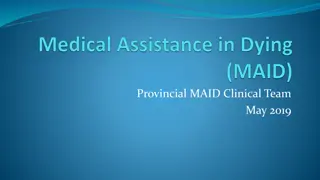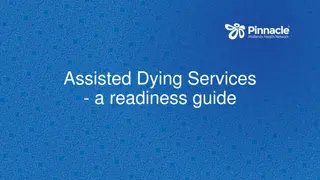End-of-Life Care Learning Outcomes and Recognition of Dying
Enhance confidence in recognizing end-of-life stages, manage symptoms effectively, understand syringe pump usage, plan care based on priorities, and navigate complicated scenarios. Learn about the North West End of Life Care Model and key signs of dying. Exclusive insights shared by Dr. Elizabeth Bailey, Medical Director of East Lancashire Hospice.
- End-of-Life Care
- Learning Outcomes
- Recognition of Dying
- Syringe Pump
- North West End
- Clinical Scenarios
Download Presentation

Please find below an Image/Link to download the presentation.
The content on the website is provided AS IS for your information and personal use only. It may not be sold, licensed, or shared on other websites without obtaining consent from the author. Download presentation by click this link. If you encounter any issues during the download, it is possible that the publisher has removed the file from their server.
E N D
Presentation Transcript
Care in Last Days of Life Dr Elizabeth Bailey Medical Director East Lancashire Hospice
Learning Outcomes To be more confident in recognising dying To increase knowledge of management of common symptoms at end of life To increase understanding of the clinical scenarios where using a syringe pump is helpful To increase knowledge of factors to consider when using a syringe pump To know about complications from using a syringe pump and how these can be managed To be able to plan care for a dying person guided by the 5 priorities for care in the last days of life 2
North West End of Life Care Model Gold Standards Framework (GSF) End of Life Care Tools Rapid Discharge Pathway (RDP) Advance Care Planning Preferred Priorities for Care care in last days of life 5 priority areas 1 2 3 4 5 Advancing disease Increasing decline Last Days of Life First Days after Death Bereavement 1 year and beyond 6 months Death 1 year The North West End of Life Care Model 3
Recognising dying Is very difficult! Important to exclude potentially reversible causes of the patient s deterioration sepsis, spinal cord compression, hypercalcaemia, pathological fracture etc clues are in the history and your assessment of the patient Recognising the key signs and symptoms of dying is an important clinical skill can mimic potentially reversible problems e.g. drug side effects The dying phase for cancer patients can sometimes be precipitous eg massive haemorrhage but is usually preceded by a gradual deterioration in functional status This predictability of the dying phase is not always as clear in other chronic incurable diseases 4
Recognising dying Deterioration in overall clinical condition Reduced fluid and food intake Weakness and fatigue Spending more time in bed Needing more help Changes in consciousness levels Extent of disease (scan reports, oncology letters etc) Some assessment tools may help Australia Modified Karnofsky Performance Status (AKPS) 5
AUSTRALIA MODIFIED KARNOFSKY PERFORMANCE STATUS (AKPS) AKPS Score Description of performance status 100% Normal, no complaints, no evidence of disease 90% Able to carry on normal activity, minor signs or symptoms of disease 80% Normal activity with effort, some signs or symptoms of disease 70% Cares for self but unable to carry on normal activity or to do active work 60% Able to care for most needs but requires occasional assistance 50% Considerable assistance and frequent medical care required 40% In bed more than 50% of time 30% Almost completely bed bound 20% Totally bedfast and requiring considerable nursing care by professionals and/or family !0% Comatose or barely arousable, unable to care for self, requires equivalent of institutional or hospital care, disease may be progressing rapidly 6 0% Dead
Recognising dying Ask yourself: In the context of this patients underlying disease and co-morbidities, is what I am seeing now expected? YES What information do I have to support this? History from patient, family, EMIS record, Colleague observations/discussion, Palliative Care CNS etc NO Is there a potentially reversible cause for what I am seeing? E.g. sepsis, MSCC, pathological fracture Is transfer to hospital appropriate? 7
Recognising dying The most important element in recognising dying is that the members of the multi-professional team caring for the patient agree that the patient is likely to die soon (GP, DN, CNS etc) Disagreement may result in mixed messages and opposing goals of care resulting in poor patient management and confused communication Communication with the patient and his/her family is important 8
Recognising dying Serious consequences of not talking about imminent death: Family is in shock Missed opportunities to say goodbye Complicated grief Patient may be admitted to hospital inappropriately Patient s wishes not met 9
Important Decisions to Make Is there a potentially reversible cause of the deterioration for which active treatment (at home or in hospital) is appropriate? Preferred place of death Who is providing care? What support do they need? Who can give it? DNA CPR if not already made Wishes regarding tissue donation if not already discussed as part of advance care plan 10
DNACPR DNACPR decision when a person is in the last days of life is a medical decision The patient (if able) and family must be informed of the decision the reasons why it has been made The patient and the family do not have a choice about the decision because there is certainty that CPR would not work Conversations around DNACPR need to be sensitive it s like breaking bad news Stress that we are aiming for a peaceful natural death 11
Tissue Donation People with long term conditions including cancer can donate tissue after their death Skin, eyes, bone, heart valves, tendons can all be donated People registered as organ donors are automatically also registered as tissue donors People can register at any time Encourage person to inform their relatives and document in their advance care plan Referral centre will ask for information about age, diagnosis and brief history they will tell you if the person is suitable and what can be donated rare to be turned down 12
Tissue Donation After death, relatives must give consent even if the person was on the register or previously expressed an interest It is very important families are given the opportunity of donation at a time where everything else seems to have been taken out of their hands and they have no control Donation is a positive act of giving during an otherwise tragic situation Families should feel able to say YES or NO (and this is perfectly ok) 13
Care in Last Days of Life Overview Patients thought to be in their last hours/days of life are cared for with kindness, compassion and competence in a way that is focused around the individual, in line with their needs and preferences and developed with them, wherever possible and /or their family 15
Plan & Do An individual plan of care, which includes food and drink, symptom control and psychological, social and spiritual support, is agreed, co-ordinated and delivered with compassion Support Communicate The needs of families and others identified as important to the dying person are actively explored, respected and met as far as possible. Sensitive communication takes place between staff and the dying person, and those identified as important to them. Involve 16 The dying person, and those identified as important to them, are involved in decisions about treatment and care to the extent that the dying person wants. If unsure, or the dying person or those important to them raise concerns, a senior clinician must review the person and the goals and plan of care. Local palliative care contact: For further guidance www.nhsiq.nhs.uk/endoflifecareunsure, or the dying person or those important to them raise concerns, a
NICE Guidance Care of dying adults in the last days of life December 2015 Very similar recommendations Regular review Individualised care Anticipatory medications (individualised) Communication emphasised Hydration specifically covered 17
Care in Last Days of Life Maintain excellent basic care - frequent assessment, action and review Regular mouth care and assessment of hygiene needs Turning for comfort as appropriate Encourage and support oral food/drink as patient is able Check bladder and bowel function - consider catheterisation 18
Care in Last Days of Life Re-evaluate daily No improvement - patient assessed as still imminently dying Continue care as above Patient's condition has improved - patient assessed as no longer dying Explore patient's understanding and wishes for treatment and care Redefine ceiling of care if appropriate 19
Care in Last Days of Life Only medicines which will control or prevent distressing symptoms should be prescribed Discontinue medicines no longer essential Prescribe medication for new symptoms which may arise Consider route of administration when patient unable to take oral medication: Prn subcutaneous injections Syringe pump Rectal 20
Use of Syringe Pump Discuss with patient (if able) and carers before syringe pump might be needed If this is not done, families may blame the syringe pump for a rapid deterioration Explain that using syringe pump is just switching to an alternative route of medicine administration not a way to escalate dose Not all dying people need a syringe pump if thought to be within hours of death, intermittent prn sc injections may be sufficient 21
Use of Syringe Pump Effective method of drug administration Less invasive than IV (or rectal) Not just for symptom control in last days of life For patients who: Are unable to take medications orally as a result of persistent nausea, vomiting, dysphagia, severe weakness or unconsciousness, head and neck surgery, bowel obstruction Are unable to absorb oral medications Are unwilling to take medicines by mouth
Syringe pump: advantages Increased comfort as repeated injections are not required Control of multiple symptoms with a combination of drugs Round-the-clock comfort because plasma drug concentrations are maintained without peaks and troughs, giving constant therapeutic drug levels over a 24-hour period
Syringe pump: advantages Mobility maintained because the device is lightweight and can be worn in a holster under or over clothes Generally needs to be loaded only once every 24 hours
Syringe pump: disadvantages Staff training Possible inflammation and pain at the infusion site and potential source of infection In emaciated patients or those on long-term infusions skin-site availability may become a problem Lack of reliable compatibility data for some mixtures of medications Daily visits from district nurses and other health professionals might be too intrusive for some patients and family
Prescribing csci The prescription should specify: The dose of each drug to be administered over the infusion period (usually 24 hours) The diluent The final volume of the infusion Compatibility of the drugs to be used should be confirmed before the pump is set up
Syringe Pump when to start It takes a few hours for the drugs are sufficiently absorbed for an effect to be seen If symptoms are uncontrolled, set up the pump immediately It may be necessary to cover the lag time with stat doses of the relevant drugs
Syringe Pump when to start If patient on MR opioid, start syringe pump up to 4 hours before the oral dose would be due If pump needed to control other symptoms and patient has taken MR opioid, start the pump with other drugs and refill with the opioid when next oral dose due
Syringe Pump Drugs For most drugs, this route of administration is off label Extensive documented clinical experience of csci with many drugs used in palliative care The injectable formulation must be of a suitable concentration to deliver the required dose in a relatively small volume The risk of local irritation is increased when injectable formulations have a pH <2 or >11
Syringe Pump Drugs Drugs in syringe pumps are generally prepared with a diluent - commonly water for injection, or sodium chloride 0.9% This dilutes the drug to minimise site reactions and enables it to be given over a set period The diluent used should be compatible with the drug e.g cyclizine needs water, octreotide needs saline The diluent may change depending on the dose/concentration of the drug
Syringe Pump Drugs If a patient needs more than one drug for symptom control, the drugs need to be compatible with the diluent and with each other If compatibility is an issue, two syringe pumps may be required Generally no more than 3 drugs should be used in the same syringe pump In exceptional circumstances 4 drugs can be used seek advice from Palliative Care Helpline
Syringe Pump Drugs: Compatibility Information about drug compatibilities is available in the Palliative Care Formulary and The Syringe Driver Book by Dickman You can phone the Palliative Care Helpline and we will check for you Also from www.pallcare.info Click on syringe drivers in main menu on left hand side takes you to the drug compatibility database Click on search Pick the drug combination from the drop down boxes Result will show in red if reports of incompatibility Result will show in green if reports of compatibility Strength of evidence also shown referenced reports/tests, single report of use Also gives you diluent to use
Syringe Pump Drugs: Compatibility Some common drugs known incompatibility: Cyclizine and oxycodone and hyoscine butylbromide; midazolam, hyoscine butylbromide and ketorolac, midazolam and dexamethasone If adding dexamethasone to a syringe pump always add it last Protect the contents of the syringe from light exposure to light can affect stability If concerns about compatibility, consider giving long acting drugs by intermittent sc injection once or twice daily e.g dexamethasone, levomepromazine
Syringe Pump Drugs: Precipitation Precipitation when mixing drugs is a sign of incompatibility Occasionally a mixture that has been used successfully will suddenly precipitate in the middle of an infusion It may be related to a reaction occurring in the subcutaneous tissue - once it has happened, it tends to recur in the same patient Cyclizine is most frequently the problem
Syringe Pump Drugs: Precipitation What to do: Change the site and the whole giving set not just the syringe Consider different diluent Consider alternative antiemetic/drugs, some drugs are too irritant for SC use diazepam, stemetil, largactil Keep away from direct sunlight or heat Separate the drugs being given into two syringe drivers Consider once or twice daily SC drugs
Syringe Pump Needle sites The best sites to use for continuous subcutaneous infusions are: The upper chest wall below the clavicle The upper arm and thigh The abdomen Occasionally the back
Syringe Pump Needle Sites Sites to avoid are: Lymphoedematous limbs the subcutaneous tissues are waterlogged with lymph fluid, which would affect absorption. There would also be increased risk of leakage or infection Any site over a bony prominence or near a joint The upper abdomen in a patient with an enlarged liver there is a risk of puncturing the liver capsule The upper chest wall in very cachectic patients there is a risk of causing pneumothorax Previous irradiated skin area
Syringe Pump Needle Site Irritation Absorption of drugs may be impaired causing poor symptom control Ensure needle tip is not too shallow Try sof-set Try a different diluent Change irritant drugs to an alternative (e.g. cyclizine haloperidol) Give irritant drugs by alternative route (e.g. rectal) Add dexamethasone 1mg to pump or hydrocortisone cream to site GTN patch over site
Use of Syringe Pump Consider what drugs need to go in the syringe pump: Analgesic? Antiemetic? Sedative? Replacement for antiepileptic drugs? Add midazolam 10mg to syringe pump (can increase up to 60mg if necessary) Ensure prn midazolam 5-10mg IM is also prescribed for fitting can be repeated after 10-20 minutes if required
Stopping the syringe pump If the patient s condition has stabilised and syringe pump no longer required switch back to oral medication Take out the csci antiemetic first and give equivalent oral doses keep the csci of other drugs going for 24-48 hours If no vomiting, switch to oral opioid: Stop the csci at the same time as starting MR opioid Stop the csci 12 hours after starting fentanyl or buprenorphine patch
Care in Last Days of Life Common symptoms at end of life Noisy breathing Pain Restlessness and agitation terminal restlessness Urinary incontinence/retention Breathlessness Dry, sore mouth Sweating Nausea and vomiting Jerking, twitching Confusion Extreme fatigue 41
Terminal Restlessness or anxiety? A thorough assessment is required in order to manage this effectively. Is the patient afraid? Are there unresolved issues? Is there spiritual anguish? Are there physical causes which may be reversible? 42
Reversible Causes Hypercalcaemia Full bladder Faecal impaction Opioid toxicity Steroids Hypoxia Infection Emotional / spiritual anguish? 43
Terminal restlessness: management Quiet well lit room Familiar objects Presence of family MDT support Clock/calendar Consider drug therapy Sedation does NOT change survival time. Terminal restlessness is an indicator of impending death, sedation to manage this is not a cause of premature death 44
Terminal restlessness: management Agitation, restlessness without confusion Midazolam 2.5mg or 5mg sc injection 2 hourly prn Consider syringe pump if more than 3 prn doses needed in 24 hours Midazolam 10mg csci via syringe pump initial 24 hour dose Titrate dose upwards depending on response Seek advice from palliative care helpline when 24 hour syringe pump dose reaches 30mg Alternating prn Midazolam with prn Levomepromazine can work well in patients not settling 45
Terminal restlessness: management Agitation, restlessness with confusion Levomepromazine 6.25 12.5mg by sc injection prn CPS says 4 hourly, PCF says can give 1 hourly 12.5-25mg by csci in syringe pump over 24 hours titrate up according to response Seek advice from palliative care helpline Can go up to 200mg if necessary! Midazolam and Levomepromazine together in syringe pump work well if patient not settled on one drug 46
Noisy Breathing Due to a build up of secretions in the back of the throat which the patient is too weak to clear Not distressing for the patient but upsets family and friends Reassure patient s family and friends Give glycopyrronium 200micrograms sc stat and start csci or hyoscine hydrobromide 400micrograms sc stat Remember that drugs used to dry up secretions will only affect the build up of new secretions not those already there so consider drug treatment early don t wait until secretions really bad 47
Noisy Breathing Glycopyrronium 200micrograms sc stat 600micrograms csci Usual maximum dose 1200micrograms in 24 hours but can go up to 2400 micrograms if necessary Does not cause agitation Hyoscine hydrobromide 400micrograms sc stat 1200micograms csci Maximum dose 2400micrograms in 24 hours Can cause agitation as crosses blood/brain barrier 48
Pain in Last Days of Life Patient often already on analgesics for pain associated with underlying illness When patient unable to take usual oral analgesics, convert to appropriate 24 hour sc dose and deliver via csci Add up total dose of regular (not prns) opioid in 24 hours Divide by 2 to get the equivalent sc 24 hour dose If pain controlled, put this dose in the pump to start when the next oral dose would be due (or within 4 hours) If pain not controlled, increase the dose by 25- 50% and put this new dose in the pump 49
Pain in Last Days of Life Example 1: patient on morphine sulphate MR 100mg bd = 200mg/24hours oral Divide by 2 = 100mg sc dose in 24 hours If patient s pain is controlled put 100mg morphine in syringe pump If patient in pain, increase dose by 25-50% depending on how many prn doses used Start syringe pump with morphine sulphate at the time the oral MR dose is due Recalculate the prn sc morphine dose (1/6 of 24 hour dose) 50
